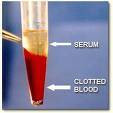RENAL FUNCTION TEST (RFT)
The
major function of the kidneys is to eliminate waste products from the body and
reabsorbed the substances essential for body function. When the kidneys’
functions are impaired, one or both processes are altered.
 |
| Image credit: Allfeline.on.com |
Measurements of the
ability of the kidneys to carry out their major processes provide vital data in
knowing whether they’re normally functioning or not.
To
know whether a kidney functions correctly we may perform different tests such
as, test for Blood Urea Nitrogen (BUN),
Creatinine and Blood Uric Acid (BUA).
CREATININE
Creatinine
is used to diagnose impaired renal function.
This
test measures the amount of creatinine in the blood. Creatinine is a catabolic
product of creatinine phosphate, which is used in skeletal muscle contraction.
The daily production of creatine and subsequently creatinine depends on muscle
mass, which fluctuates very little.
Creatinine, as BUN, is excreted entirely by
kidneys and therefore is directly proportional to renal excretory function.
Thus, with normal renal excretory function, the serum creatinine level should
remain constant and normal.
Only renal disorders such as glomerulonephritis,
pyelonephritis, acute tubular necrosis, and urinary obstruction, will cause an
abnormal elevation in creatinine.
There are slight increases in creatinine
levels after meals, especially after ingestion of large quantities of meat.
Furthermore, there may be some diurnal variation in cr.
The
serum creatinine test, as with the BUN, is used to diagnose impaired renal
function. Unlike BUN, however, the creatinine level is affected minimally by
hepatic function.
The serum creatinine level has much the same significance as
the BUN level but tends to rise later. Therefore elevations in creatinine
suggest chronicity of the disease process.
In general, a doubling of creatinine
suggests a 50% reduction in the glomerular filtration rate. The creatinine
level is interpreted in conjunction with the BUN.
NORMAL
VALUES:
v ELDERLY decrease in muscle mass may cause
decreased values
v ADULT
FEMALE 0.5-1.1 mg/dL or 44-97 umol/L
MALE
0.6-1.2 mg/dL or 53-106 umol/L
v ADOLECENT 0.5-1.0 mg/dL
v CHILD 0.3-0.7 mg/dL
v INFANT 0.2-0.2 mg/dL
v NEWBORN 0.3-1.2 mg/dL
INTERFERING FACTORS
v A high diet in meat
content can cause transient elevations of serum creatinine.
v Drugs may increase
creatinine values include aminoglycoside (e.g. gentamicin), cimetidine,
heavy-metal chemotherapeutic agents (e.g. cisplatin), and other nephrotoxic
drugs such as cephalosporins (e.g. cefoxitin)
TEST RESULTS AND CLINICAL SIGNIFICANCE
Disease affecting renal function,
such as glomerulonephritis, pyelonephritis, acute tubular necrosis, urinary tract
obstruction, renal blood flow (e.g. shock, dehydration, congestive heart
failure, atherosclerosis), diabetic nephropathy, nephritis. With these
illnesses, renal function is impaired and creatinine levels rise.
Rhabdomyolysis. Injury of the
skeletal muscle causes myoglobin to be released in the blood stream. Large
amounts are nephrotoxic. Creatinine levels rise.
Acromegaly
Gigantisim
These diseases are associated
with increased muscle mass, which causes the “normal” creatinine level to be
high
Debilitation
Decreased muscle mass (e.g.
muscular dystrophy, myasthenia gravis)
The diseases are associated with
decreased muscle mass, which causes “normal” creatinine level to be low.
